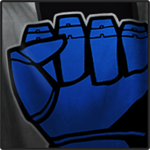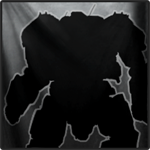Some more thoughts on Hit Chance and HP distributions in MWO versus Table-Top:
If you assumed 40% of hits would get the CT, another 40% would get the LT and RT, and the remaining 20% would be spread across the arms and legs and rebalanced HP accordingly, then you'd end up with much weaker arms and legs, and slightly weaker side torsos (relative to CT). At that point, you would actually have to think about your return-on-investment for what you were shooting at. Yes, shooting the CT is the still the fastest way to actually kill a mech (and would probably be the default mode of operation) but you would now have a real incentive to aim for that Centurion or Stalker's arms first, because it becomes much easier to disarm him before going for the kill (although at the cost of being a harder shot to make consistently). You can't have it be 100% reactive, but a little bit of rebalancing of the default would change the current status quo of "yeah, I COULD aim for something else, but it takes only slightly longer to just core him out that I might as well just focus on the CT".
For reference, a 50t mech has the following structure HP distribution in TT (not including the Head):
LL: 15%
LA: 10%
LT: 15%
CT: 20%
RT: 15%
RA: 10%
RL: 15%
If you multiply that by the expected chance of being hit (and then divide it by the CT) you get the normalized durability of each section:
Center Torso: 3.89 => 1.00
Side Torsos: 2.08 => 0.54
Arms: 1.39 => 0.36
Legs: 1.67 => 0.43
This is all assuming maximum armor on each component (i.e. that the total proportional HP for each section is the same as the proportional IS HP). So in tabletop, the flow of combat would be that on average you would lose your arms roughly 3x sooner than your CT, and that it would take about 150% longer to lose a side torso than an arm.
Of course, this is only *really* true if you're being shot with nothing but cluster after cluster of LRMs or a battery of small lasers, because weapons that have larger damage packets will basically make the results diverge much more from the average. This is a good illustration of why weapons like the AC/20 are so effective -- high DPS is great for whittling away an enemy, but he's going to be up and operational in some way or another for a long time, especially if he has good weapons in his torso; meanwhile, something with high damage focus can allow you to knock your target out much more quickly with a "lucky" shot.
This also doesn't account for things like actual armor allocation. If you are in a mech that has a lot of its important weapons in the arms (like the Centurion, for example) then keeping your CT alive probably doesn't matter as much if your arm gets blown off anyways, so you can rebalance armor away from your torso a little to flatten out this curve.
Now, again, I wouldn't claim that even the derived tabletop numbers are necessarily the ones that we should be aiming for; however, because of several systems in MWO, these interesting game mechanics are completely missing. Since all of the lasers focus on one location, there's functionally no difference in terms of damage distribution between an AC/20 hunchback and one with 4xMedium Lasers in it's hunch. In fact, the HBK-4P ends up having much higher burst damage and concentrated firepower than the HBK-4G, which completely inverts the character of these mechs on the tabletop. PGI tries to balance this with the heat of Medium Lasers, but really the fact that the "feel" is so backwards in this regard to me indicates they're barking up the wrong tree. Meanwhile, because damage is so focused compared to HP distribution, it never really makes sense for a Centurion to shift armor from his torso to his arms, because as often as not his CT is the first thing to go (and if not, he's at least likely to lose the side torso that the arm is connected to).
Edited by Hubis, 29 July 2013 - 06:30 AM.













